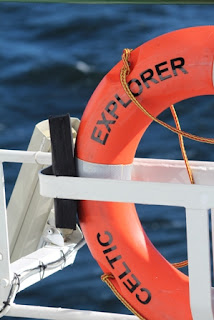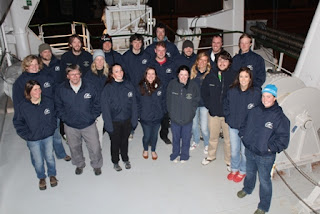The Seabird team had sightings of typical inshore species not seen during the offshore leg of the expedition such as Great Black-backed Gull, Herring Gull, Common Gull, Red-Throated Diver, Shag, Cormorant, Razorbill & Guillemot. Other birds of note included a Manx Shearwater & a 'Blue' Fulmar.
Strong North-westerly winds coming off the mainland made observations difficult at times for both teams. On Saturday night the zooplankton team completed 2 stations but unfortunately didn't connect with the hoped for barrel jellyfish off Rosslare.
 |
| Hook Head, Co. Wexford (C) Lilian Lieber |
 |
| R.V. Celtic Explorer (C) Lilian Lieber |
The R.V. Celtic Explorer made her way into Cork Harbour at 18:45 on Sunday evening. The Cetaceans on the Frontier III Survey achieved more than anyone could have hoped for. All three teams collected extremely valuable data which will provide a solid baseline for future monitoring.
I wish to thank everyone for their support during our expedition. I would also like to especially thank the crew of the R.V. Celtic Explorer for making all of the scientists feel at home and for assisting us in this successful research expedition. To my fellow researchers, it was an absolute pleasure meeting and working with you. I hope to see you all again next year for Cetaceans on the Frontier Expedition IV!
 |
Chief Scientific Officer: Dr. Joanne O'Brien (right) & 2nd Scientific Officer: Conor Ryan (left) (C) Lilian Lieber
|
 |
| The Cetaceans on the Frontier III Research Team (C) Lilian Lieber |
Basking Shark Scientist: Lilian Lieber
Seabird Team: Jackie Hunt, Derek McLoughlin, Eamonn O'Sullivan and Niall Keogh.
Plankton/Jellyfish Team: Catherine O'Sullivan, Fergal Glynn and John Power.
Cetacean Team: Dr. Joanne O'Brien, Conor Ryan, Clo Collins, Dave Williams, Enda McKeogh, Laurence Manning, Mareike Volkenandt, Róisín Pinfield, Randal Counihan, Paddy O'Dwyer, Suzanne Beck and Teresa Martin.
~ For the Cetaceans on the Frontier III Survey this is Teresa Martin signing off. ~
The Cetaceans on the Frontier III survey was supported under the Marine Institutes’ competitive ship-time scheme, funded through the Marine Research Sub-programme of the National Development Plan 2007–2013, as part of the Sea Change strategy.
http://www.marine.ie/home/aboutus/newsroom/news/TheRVCelticExplorerseeksoutwhalesdolphins.htm


















.JPG)





